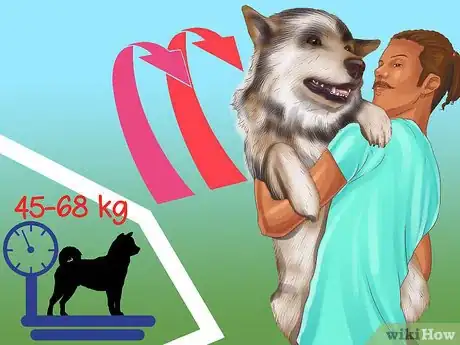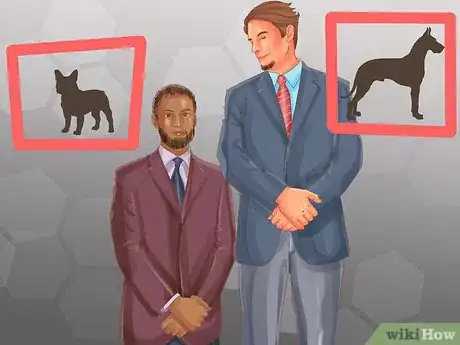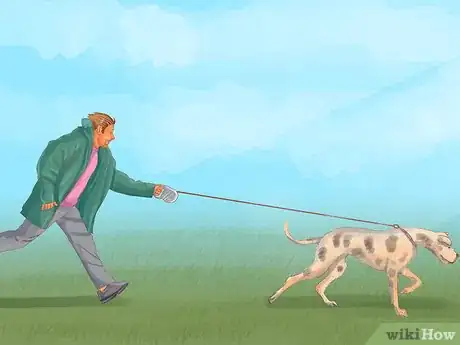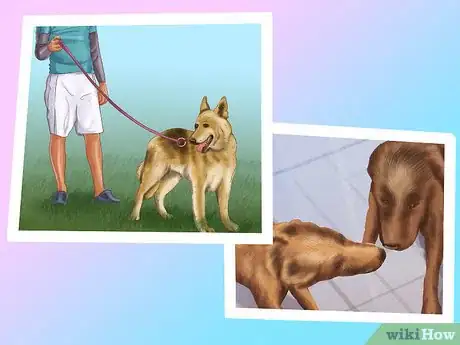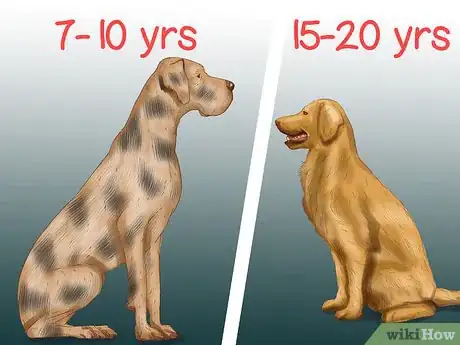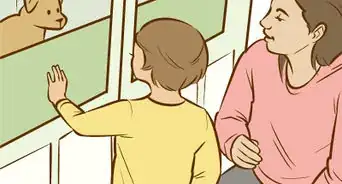This article was co-authored by Dani Pedraza. Dani Pedraza is a Professional Dog Trainer and a Co-Owner of The Big City Woof Walker with presences in NYC and Chicago. Dani is passionate about providing personal, quality pet service and treatment and is very knowledgeable about training dogs using positive reinforcement and a force-free approach. As a Certified Dog Trainer (CCDT), Dani graduated from CATCH Canine Trainer Academy’s Master Course program.
There are 7 references cited in this article, which can be found at the bottom of the page.
This article has been viewed 18,547 times.
Large breed dogs can be great companions and a loving addition to a family. Before you bring home a large breed dog, it is important that you consider your ability to physically handle the dog during training and if it gets hurt. You should also evaluate your living conditions and determine if you have enough space to care for a big dog properly. Finally, you should be aware of the unique responsibilities that large breed dog ownership entails so that you are capable of handling the emotional, medical, and financial burdens that come with it.[1]
Steps
Examining Your Ability to Physically Handle a Big Dog
-
1Determine your physical stamina. A full-sized large dog can weigh between 100 and 150 pounds (45 to 68 kg), with some of the larger breeds maxing out at 200 pounds (91kg). Owning and caring for a big dog will require that you lift and move a relatively large amount of weight. This will become particularly important as the dog ages and it loses some of its mobility due to arthritis and other joint issues.[2]
- If your dog is injured, you may have to pick it up. For any dog over 40 pounds (18kg), make sure that you have someone help you lift it. This will ensure that the dog does not wiggle out of your grasp and fall, injuring itself further.
- Because your large dog eats a lot of dog food, you will also need to be able to regularly lift and move heavy bags of dog food.
- You could also talk with your veterinarian about your ability to care for a large dog.
-
2Evaluate your physical stature. Some large breed dogs can grow to weigh more than some humans. If you are a smaller statured person, owning a large dog presents some challenges. Because of its size, a larger dog would have a much easier time pushing and pulling you around. This is particularly true if you do not train your dog properly.[3]
- For example, if you are smaller statured, a large dog may pull you around during walks if it is not trained properly.
Advertisement -
3Test out caring for a big dog. If you know someone who owns a large dog, ask him or her if you could see what it is like to care for such a big animal. Take the dog for a walk and see if you are able to rein the dog in and control it. Take the dog to your place and see if it has enough space to lounge around. Try lifting the animal's large bags of dog food. If you have any family members, have them meet the dog and spend some time around it.
- Understand that everything is on a big scale with a large dog. From the amount of hair it sheds to the to the size of its feces.
- Be aware of the practical aspects of owning a big dog. For example, a big dog requires a large vehicle to transport them. This can make simple family day trips with the dog complicated because of space.
-
4Know that proper training can help anyone control a large dog.[4] Although the prospect of physically handling a large dog may seem daunting, anyone can control a big dog with the proper training. If you leash train your dog and teach it to obey simple commands, you should be able to walk a dog regardless of you or the dog's size.[5]
- A big dog should be trained in the same manner as other dogs. Be sure to use an even tone and positive reinforcement to train your dog. Loud voices and harsh reprimands can lead some large breed dogs to develop behavioral issues like obstinacy and aggression.
- It is important that your also socialize your dog properly so that it does not get out of control around other dogs.
Evaluating Your Living Conditions
-
1Check with your property owner. If you live in a rental property, check with the owner to make sure that they allow large dogs. Many large property management companies have size, weight, and breed restrictions for the dogs that they allow in their properties. If your property manager does not allow large breed dogs, you may need to reconsider getting a big dog or look for a new place to live.[6]
- If you are having a difficult time finding places for you and your dog, consider bringing the dog along to meet the owner or create a pet resume to show your dog's good behavior.
-
2Recognize that large dogs need space. If you live in a small apartment, a large dog may not be a good fit. Big dogs need space to spread out. Large dogs have a tendency to be clumsy and bump into things, a problem that is magnified in a small apartment. Ideally, a large dog does best in a home with a large yard or park nearby.[7]
- Because they are accident prone, a large dog might damage your home and knock over or break fragile items.
-
3Look for nearby parks and open space. Some larger dogs, like German Shepherds, tend to be very active. They need a lot of physical activity and play to stay mentally stimulated and healthy, which a park or green space facilitates.[8]
- However, many large breed dogs only need about 30 minutes of exercise a day. They spend the rest of their time lounging around.
- Make sure that you get a breed of large dog that meets your activity expectations.[9]
Understanding the Unique Responsibilities of a Large Dog
-
1Think about your family's safety. Although most large dog breeds are good with kids, they can be a little clumsy and can hurt small children. Especially when they are young, big dogs have a difficult time accounting for their size and often knock smaller children over. You will want to make sure that a large dog is a good and safe fit for your family.[10]
- A big dog is a great option for a family with older children who can play with the dog and give it plenty of exercise.
-
2Recognize that large dogs live shorter lives. On average, larger dogs live much shorter lives than small and medium sized dogs. Make sure that you are emotionally capable of handling your dog's shorter lifespan. It is important the understand that the time that you spend with your dog will be relatively brief, especially if the dog is adopted or rescued.[11]
- The lifespans of many larger breed dogs are often half of that of smaller dogs. Many small to medium sized dogs can live for 15 to 20 years. However, large dogs may only live for 7 to 10 years.
-
3Understand that providing medical care for a large dog can be pricy. Medication for large dogs is more expensive than medication for smaller dogs, as most are dosed according to size. Be certain that you can afford predictable monthly costs such as preventative heartworm medication. Also, make sure that you're financially prepared for emergency veterinary visits in case they ever happen.
- Because of their large size, many larger breed dogs develop joint and bone issues as they age. This can limit their mobility and lead to changes in their temperament. Caring for your ailing dog can also be a financial burden due to increased veterinary and medical expenses.[12]
- In order to help with your dog's joint health, consider feeding it a diet high in healthy fatty acids.
- If you run with your larger dog, try to exercise on dirt or woodchip trails to minimize joint damage.
- Because of their large size, many larger breed dogs develop joint and bone issues as they age. This can limit their mobility and lead to changes in their temperament. Caring for your ailing dog can also be a financial burden due to increased veterinary and medical expenses.[12]
-
4Understand that feeding a large dog can be expensive. A large breed dog will eat between 4 ¼ and 6 cups (435 to 610g) of dog food a day. This is twice as much food as a medium sized dog. Because they eat so much food, you will end up spending significantly more money feeding your large dog. It is important that you understand the financial responsibilities of feeding a big dog before you bring one home.[13]
- The monthly cost of food for a large dog is about $60. However, this can be significantly higher or lower depending on the quality of food you feed it.
Expert Q&A
-
QuestionWhat do I need to know about getting a big dog?
 Osama MaghawriOsama Maghawri is a Dog Trainer and Founder of OneStopK9, a dog training service in Miami, Florida. Osama utilizes balanced training methods to teach communication between owners and dogs. He specializes in basic obedience and behavioral issues such as resource guarding, fear-based aggression, and leash reactivity. Osama also helps owners understand the behaviors of their breed and how to continue training on their own in the future.
Osama MaghawriOsama Maghawri is a Dog Trainer and Founder of OneStopK9, a dog training service in Miami, Florida. Osama utilizes balanced training methods to teach communication between owners and dogs. He specializes in basic obedience and behavioral issues such as resource guarding, fear-based aggression, and leash reactivity. Osama also helps owners understand the behaviors of their breed and how to continue training on their own in the future.
Professional Dog Trainer In general, big dogs tend to need more space and exercise. However, every breed is different! I suggest you thoroughly research the specific breed you're interested in to make sure you adopt a dog that matches up with your lifestyle and expectations.
In general, big dogs tend to need more space and exercise. However, every breed is different! I suggest you thoroughly research the specific breed you're interested in to make sure you adopt a dog that matches up with your lifestyle and expectations.
References
- ↑ Osama Maghawri. Professional Dog Trainer. Expert Interview. 9 September 2020.
- ↑ http://www.fidosavvy.com/extra-large-breed-dogs.html
- ↑ http://www.fidosavvy.com/extra-large-breed-dogs.html
- ↑ Osama Maghawri. Professional Dog Trainer. Expert Interview. 9 September 2020.
- ↑ Dani Pedraza. Professional Dog Trainer. Expert Interview. 24 February 2021.
- ↑ https://www.petfinder.com/blog/2014/08/tips-for-owning-a-big-dog-in-a-small-apartment/
- ↑ http://www.petmd.com/dog/care/evr_dg_before_getting_a_dog
- ↑ http://www.fidosavvy.com/extra-large-breed-dogs.html
- ↑ Osama Maghawri. Professional Dog Trainer. Expert Interview. 9 September 2020.
- ↑ http://www.fidosavvy.com/extra-large-breed-dogs.html
- ↑ http://www.petmd.com/dog/wellness/evr_dg_how_long_do_dogs_live
- ↑ http://www.fidosavvy.com/extra-large-breed-dogs.html
- ↑ http://www.petmd.com/blogs/nutritionnuggets/dr-coates/2015/july/are-you-feeding-your-dog-right-amount-32905
- ↑ Osama Maghawri. Professional Dog Trainer. Expert Interview. 9 September 2020.
About This Article
To know if you can handle a big dog, think about your own physical size, since the dog may be able to push and pull you around if you’re small. You should also consider whether you’re strong enough to regularly lift large bags of dog food, which you’ll need to do when feeding it. If you live in a rented property, ask your landlord if they have any size restrictions. Before making a final decision, remember that large dogs require a lot of exercise and living space, which you may not be able to provide if you live in a small apartment or don’t have a park nearby. For tips from our Veterinary co-author, including how to provide medical care for a large dog, keep reading!

